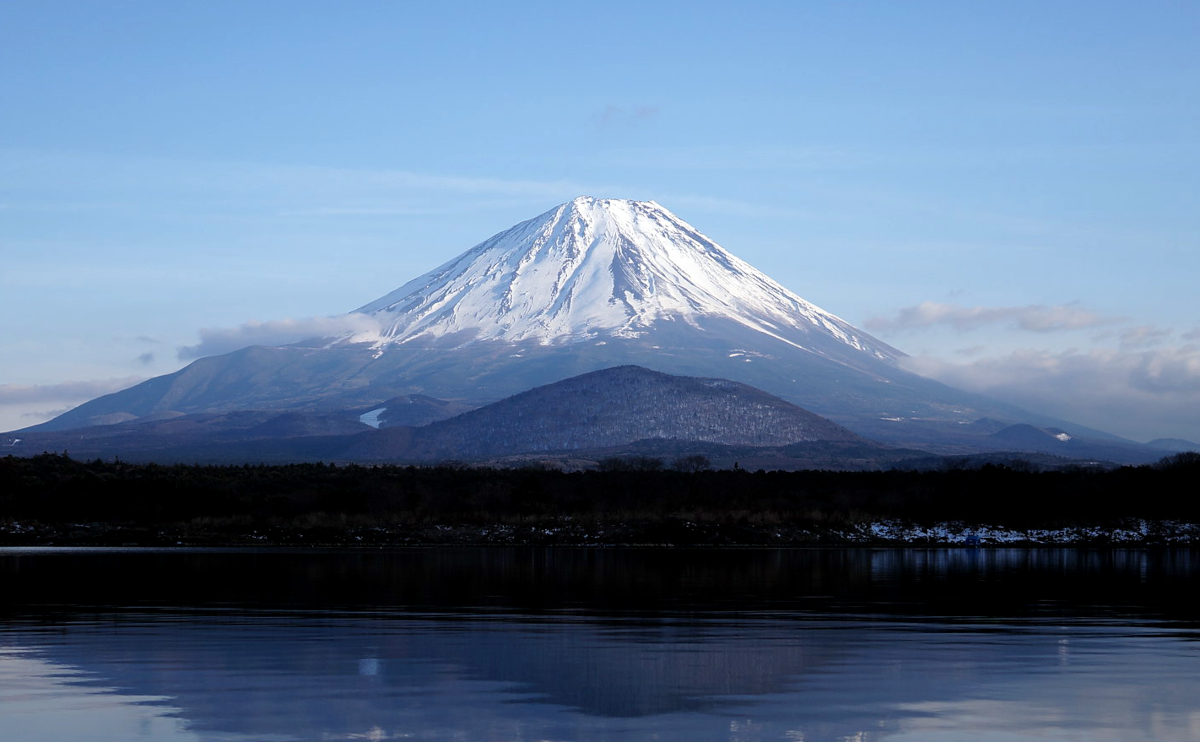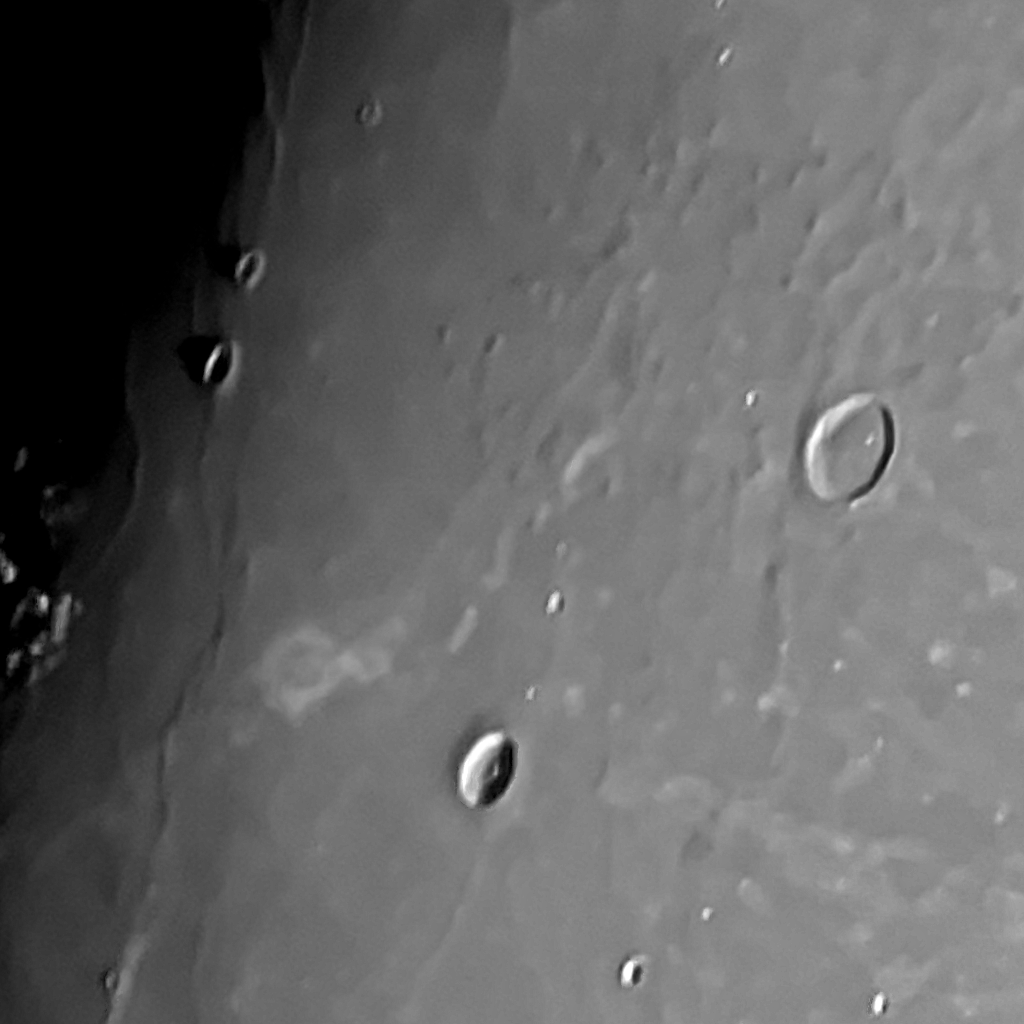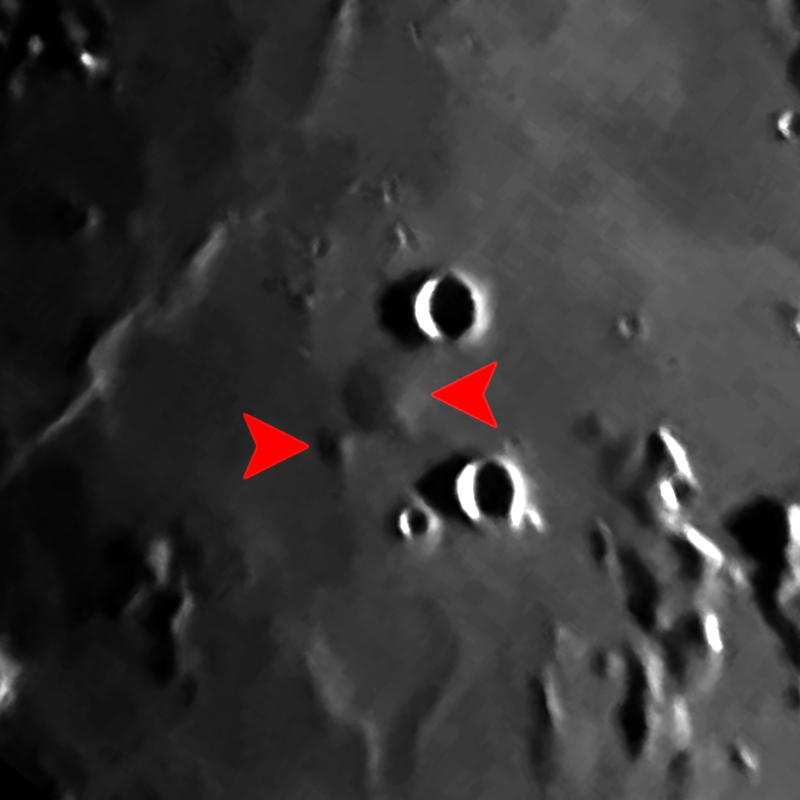Like many other amateur astronomers, I redoubled my efforts at observing during the pandemic when we all suddenly had a lot more time on our hands. That experience brought me back to a love of lunar astronomy. In many respects, it's ideal for an observer: it's available even to users of small telescopes, and lunar visibility remains unaffected in the presence of light pollution. Even though its surface is essentially unchanging, the appearance of the Moon through a telescope changes hour to hour and night to night. And it's the only Solar System body on which significant detail can be seen by earthbound observers.
Becoming reacquainted with observing led me to look for some semi-organized projects I could do that would give some direction to my work. In particular, I wanted to take on some observing programs that extended opportunities into the bright parts of months. While looking at the Moon generally more often in the past, I realized that there was a lot I had never seen before. In 2022, I serendipitously observed some lunar volcanic features known as "domes". These are fascinating and somewhat elusive lunar geologic structures that make for some challenging observing. I decided to start looking for them more regularly, which turned into a passion to study them systematically.
Becoming reacquainted with observing led me to look for some semi-organized projects I could do that would give some direction to my work. In particular, I wanted to take on some observing programs that extended opportunities into the bright parts of months. While looking at the Moon generally more often in the past, I realized that there was a lot I had never seen before. In 2022, I serendipitously observed some lunar volcanic features known as "domes". These are fascinating and somewhat elusive lunar geologic structures that make for some challenging observing. I decided to start looking for them more regularly, which turned into a passion to study them systematically.
The Lunar Dome Project
This project aims to identify as many lunar domes as I can that are of a physical size that they're readily observable with my small (8-inch / 20 cm) telescope. Fortunately the geologic processes that yield these volcanoes involve a characteristic size scale that makes them readily observable from Earth. Of course there is a continuum of sizes down to features much smaller than domes; these can be identified on spacecraft images of the Moon taken from lunar orbit, but they're far too small to be resolved by telescopes on Earth.
As outputs from the project, I want to:
Longer-term, I plan to compile a detailed list of all domes (and other volcanic features) on the lunar near side that are sufficiently large that they can be observed with 'typical' amateur-sized telescopes.
As outputs from the project, I want to:
- Introduce the subject to the novice
- Put domes into the overall context of lunar geological history
- Provide some notes from my own observing experience
- Recommend a short list of the best examples within the range of most observers
- Offer some tips on how to see and photograph domes
Longer-term, I plan to compile a detailed list of all domes (and other volcanic features) on the lunar near side that are sufficiently large that they can be observed with 'typical' amateur-sized telescopes.
Introduction to lunar domes
In short, lunar domes are a variety of shield volcano, a type of igneous feature that we see on Earth and other planets and moons, most notably Mars, Venus, and Jupiter's large moon Io. Shield volcanoes take their name from their typically low profiles, resembling a warrior's shield if it were laid face-up on the ground. They take this shape because their lavas have low viscosity, meaning that they flow readily almost like water. Wherever such fluid lavas are found in the Solar System, they tend to produce shield volcanoes resembling those we see on Earth.
|
Schematic diagram of a terrestrial shield volcano.
Credit: U.S. Geological Survey |
By contrast, the other main type of volcano — a 'stratovolcano' — form from much thicker (i.e., high-viscosity) lavas. They are sometimes called "composite volcanoes" because they are built up from layers formed over many successive eruptions in which their thick lavas don't travel very far. The prototypical examples of each type are Mauna Loa (shield) and Mount Fuji (strato). The images below show their very different shapes and profiles.
The Moon as a volcanic world
Lacking oceans and substantial water, the Moon's geologic setting and history is dominated by volcanism. In what has become known as the giant-impact hypothesis, the Moon is believed to have formed 4.5 billion years ago in a titanic collusion between Earth and a Mars-sized world called Theia. While the main body of the second planet substantially merged with the interior of the Earth, some amount of the outside of both objects was blasted into orbit around the young Earth. From this material condensed the Moon. Its nearly global magma ocean crystallized fairly quickly (within ~100 million years of the formative impact), forming a solid crust that was repeatedly pierced by further impacts by other Solar System bodies. This process resulted in much of the topography of the Moon's near side, including several large, nearly circular impact basins.
|
Geologic eras of the Moon and Earth drawn on a common timescale. The period of time in which lunar domes formed on the maria is indicated. (diagram by Jean Pierre Williams)
|
As the crust formed, heavy elements sank to the Moon's center, forming its core, while lighter ones floated to the surface. This stratified the interior into a core-mantle-crust structure as on the Earth. Large, basin-forming impacts happened during a fairly short window of time from 4 to 3.85 billion years ago, puncturing the surface repeatedly. From around 3 billion years ago, basaltic lavas — a much darker material than the adjacent highlands — welled up from the depths and filled the basins. The dark lava plains, mistaken for oceans by early telescopic observers, form the features of the familiar "man in the Moon" pattern of the near side. The process was essentially complete by about 1 billion years ago, at which point the Moon would have looked much as it does today.
Properties of lunar domes
It was largely onto these plains that later eruptions formed the lunar domes. Because they are superimposed on the maria, we know they must be younger than the surfaces beneath them. "On the basis of age ranges of mare deposits established by Apollo samples," Head and Giffords wrote in 1980, "mare vent-related domes formed over an approximately one billion year period starting about 3.7 [billion years] ago." By the end of the period in which the domes were formed, widespread lunar volcanism had effectively ended. This offers some clue to the rate of cooling of the lunar interior, given that magma was no longer being moved to the surface.
Domes can be produced either by an extrusion of volcanic material onto the surface, similar to shield volcanoes on Earth ("extrusive domes"); or as the result of an uplifting of the surface due to pressures from magma or chemical changes below the surface, similar to laccoliths on Earth ("intrusive domes"). Extrusive domes often show what appear to be craters at their summits; these are interpreted as calderas from which lava once spewed. On our planet, laccoliths are often revealed when softer rocks above them are eroded away, leaving behind isolated mountains ('volcanic plugs') or mountain ranges. But a lack of significant erosion on the Moon means that domes maintain their characteristic mound shapes over billions of years. Although the distinction is not totally clear, some raised structures on the Moon are separately listed as lunar volcanoes.
The silicic volcano Mairan T stands out brightly from the surrounding lava plains of Oceanus Procellarum. The large central depression represents the collapse of the volcano's central vent during the final stages of eruption about 3.35 billion years ago. This Lunar Reconnaissance Orbiter Camera view looks west-to-east and is about 6 km in width. Image NAC M1387416559LR [NASA/GSFC/Arizona State University].
A typical lunar dome measures between 5 and 7.5 miles (8-12 km) in diameter with a peak or caldera roughly 900 feet (300 meters) high. Because the lavas that formed them were very runny, they have gentle slopes of only a few degrees at most. As many domes have slopes of only around one degree, an astronaut would not have difficulty walking to the top of one. Combined with their relatively small sizes, that also makes them challenging targets for telescopic observation on Earth. Unlike other lunar mountains that can have considerably steeper slopes, they cast only short shadows during the brief time that they are the terminator (the dividing line between day and night).
Domes often cluster together over some geographic extent, reminiscent of distributed volcanic fields on Earth. On the near side of the Moon there are a few particularly conspicuous examples such as Mons Rümker, the Marius Hills and the Gardner 'Megadome'. These appear to be single, large shield volcanoes with multiple vents. But we also see many small, isolated domes scattered across the maria. Like volcanism on Earth, the lunar equivalent is diverse.
Domes often cluster together over some geographic extent, reminiscent of distributed volcanic fields on Earth. On the near side of the Moon there are a few particularly conspicuous examples such as Mons Rümker, the Marius Hills and the Gardner 'Megadome'. These appear to be single, large shield volcanoes with multiple vents. But we also see many small, isolated domes scattered across the maria. Like volcanism on Earth, the lunar equivalent is diverse.
Left to right: Mons Rümker, the Marius Hills and the Gardner 'megadome'.
All images by the Lunar Reconnaissance Orbiter Camera (NASA/ASU)
All images by the Lunar Reconnaissance Orbiter Camera (NASA/ASU)
There is no widely recognized convention for assigning names to lunar domes. Nomenclature of features on Solar System objects is traditionally determined by the International Astronomical Union, but it has yet to publish any system for naming domes. Elevated areas on the Moon, a very few of which are domes, were traditionally designated by the name of a nearby crater followed by a Greek letter. More recently they have been named by using the Latin prefix mons ('mountain', 'mount', 'hill'). The IAU-approved Latin suffix "tholus" is theoretically available to designate a "small domical mountain or hill" but has never been used on the Moon.
Lists of lunar domes
Given the lack of IAU leadership on nomenclature, there does not seem to be any comprehensive list or agreed-upon convention for naming lunar domes. One of the earliest lists, based largely on British Astronomical Association Lunar Section observations, was compiled by Moore and Cattermole and published in four parts between 1957 and 1959. Brungart (1964) compiled a catalog of 261 domes accompanied by maps and drawings from visual observations and estimates of the features' diameters, summit heights and slope angles.
Beginning in the late 1950s, spacecraft launched to the Moon began revealing its surface with a level of detail unobtainable from the ground. Smith (1973) published a list of about 300 suspected lunar volcanic features, many of which were domes, identified in Lunar Orbiter images. The Apollo missions provided considerably more image data. Head and Gifford (1980) identified 68 definite and 13 suspected domes. And in 2001, an amateur group headed by Marvin W. Huddleston published The Comprehensive Catalog of Lunar Domes, representing the cumulative contributions of dozens of Association of Lunar and Planetary Observers members.
The Geological Lunar Researches Group, "a loosely-affiliated group of amateur lunar scientists" apparently centered in Italy, issued its own GLR Lunar Domes Catalog in 2004. Prepared by Charles Kapral and Robert Garfinkle, it collates the listings from the earlier catalogs and new discoveries claimed by the GLR. The catalog contains 1107 putative lunar domes, of which it says 168 are "verified". A more recent GLR publication, the Consolidated Catalog of Lunar Domes, only discusses 84 of the more well-studied examples of domes.
Beginning in the late 1950s, spacecraft launched to the Moon began revealing its surface with a level of detail unobtainable from the ground. Smith (1973) published a list of about 300 suspected lunar volcanic features, many of which were domes, identified in Lunar Orbiter images. The Apollo missions provided considerably more image data. Head and Gifford (1980) identified 68 definite and 13 suspected domes. And in 2001, an amateur group headed by Marvin W. Huddleston published The Comprehensive Catalog of Lunar Domes, representing the cumulative contributions of dozens of Association of Lunar and Planetary Observers members.
The Geological Lunar Researches Group, "a loosely-affiliated group of amateur lunar scientists" apparently centered in Italy, issued its own GLR Lunar Domes Catalog in 2004. Prepared by Charles Kapral and Robert Garfinkle, it collates the listings from the earlier catalogs and new discoveries claimed by the GLR. The catalog contains 1107 putative lunar domes, of which it says 168 are "verified". A more recent GLR publication, the Consolidated Catalog of Lunar Domes, only discusses 84 of the more well-studied examples of domes.
Observing lunar domes
Positively identifying lunar domes through either visual or photographic observation is often challenging. Their appearance is very sensitive to their position with respect to the terminator on a given night, as well as telescope aperture and momentary seeing conditions. Because they don't have sufficient vertical relief to cast long shadows, glimpses of domes are often fleeting in time. Where they cluster together in volcanic fields, or individual domes are near other, more recognizable features like craters and mountains, it may be easier to see them. Nights with good seeing are generally required to detect most individual domes, as atmospheric turbulence easily reduces the effective angular resolution of any given telescope. All that said, the lunar domes can be detected with remarkably small telescopes. Some of the larger and more conspicuous domes can be seen with telescopes having apertures as small as about three inches (76 mm).
In my own experience, observing domes means understanding their locations clearly from the context of photographs and maps, centering the location in the telescope field of view, and then waiting for moments of atmospheric calm when they pop into view. Patience is a must! It also helps to predict in advance, for any given dome, when its location is best situated with respect to the terminator in order to make positive observations more likely.
In my own experience, observing domes means understanding their locations clearly from the context of photographs and maps, centering the location in the telescope field of view, and then waiting for moments of atmospheric calm when they pop into view. Patience is a must! It also helps to predict in advance, for any given dome, when its location is best situated with respect to the terminator in order to make positive observations more likely.
|
Mons Rümker, an isolated volcanic formation in the northern part of Oceanus Procellarum. The mound has a diameter of 70 km and reaches a maximum elevation of about 1300 meters above the surrounding plain.
|
An area in Oceanus Procellarum roughly centered on the west-northwest edge of Mare Cognitum. The red arrowheads points to three low domes near the crater Lansberg D.
|
The region of western Oceanus Procellarum. Northwest of the crater Marius (right) are the "Marius Hills", a dome field that was the alternate landing site for the Apollo 15 mission.
|
Similarly, domes can be photographed reasonably well with modest equipment. The three images above are ones I made with an iPhone 12 Mini and a Celestron NexYZ 3-Axis Universal Smartphone Adapter using eyepiece projection. To deal with the problem of often poor seeing during any particular still frame, I use the "lucky imaging" method. I take 4K video at 60 frames per second, which I import into Siril, a software application for astrophotography. The software analyzes frames and selects those with the best seeing, then combines them to a final result that can then be further adjusted with any photo application.
The Top 10 Lunar Domes
From my own observations and readings, I have selected a list of the ten best lunar domes that are readily within reach of most users of small telescopes. These are summarized in the table below.
Number |
Name |
Latitude (ºN) |
Longitude (ºE) |
Rükl Chart |
Diameter (km) |
Days past new |
Note |
1 |
Mons Rümker |
40.656 |
-58.508 |
8 |
66 |
12-13 |
"Megadome" of overlapping features |
2 |
Marius Hills |
14.000 |
-52.000 |
18, 28, 29 |
330 |
12 |
Dozens/hundreds of cones atop a single, large shield |
3 |
Gruithuisen γ and δ |
36.242 |
-40.128 |
9 |
20 and 13 |
11 |
Large, flat-topped features northeast of the Aristarchus region |
4 |
Milichius π |
10.082 |
-31.249 |
30 |
4 |
10 |
Among the best examples with relatively high vertical relief, making for a relatively easy observing target |
5 |
Capuanus |
-34.041 |
-26.675 |
63 |
7 |
9-10 |
Several low domes within the crater's walls, of which one is prominent |
6 |
Kies π |
-26.923 |
-24.278 |
53 |
11 |
9-10 |
Prominent feature due east of the Kies Crater in Mare Nubium whose summit caldera can be glimpsed through small telescopes in moments of good seeing |
7 |
Valentine |
30.881 |
10.059 |
13 |
30 |
7 |
An unusually large effusive dome on the northwest shore of Mare Serenitatis |
8 |
Arago α and β |
6.867 |
20.705 |
35 |
24 and 23 |
6 |
Two comparably sized, easy-to-spot features located equidistant from the crater Arago near the western shore of Mare Tranquillitatis |
9 |
Gardner |
17.377 |
35.100 |
25 |
70 |
5 |
"Megadome" of overlapping features |
10 |
Cauchy ω and τ |
7.375 |
37.531 |
36 |
10 and 14 |
4 |
Most conspicuous members of an extended volcanic field in eastern Mare Tranquillitatis |
|
Full Moon image by the author overlaid with markers indicating the positions of the Top 10 Lunar Domes
|
Table notes
1. Feature names are those in common use (i.e., they are not standardized by the IAU). 2. Positions are given in the selenographic coordinate system where the 'prime meridian' is defined as the line of longitude drawn between the lunar poles and passing through the center of the nearside disc. 3. The 'Rükl Chart' refers to the chart number in Atlas of the Moon by Antonin Rükl (2004, Sky Publishing Corp, ISBN 1-931559-07-4). I strongly recommend this atlas to any serious lunar observer. 4. 'Days past new' is the approximate number of days past new moon when the feature is most prominently visible due to the low sun angle on that date. |
Additional information and resources
There are a number of great resources available on the web that serve extensive maps and spacecraft imagery. These include:
The Moon Wiki is a vast repository of information about our nearest neighbor, including about lunar domes. Bob King's 2016 article on domes for Sky and Telescope magazine is a classic. The definitive research volume about domes appears to be Lunar Domes: Properties and Formation Processes, by experts Raffaello Lena, Christian Wöhler, Jim Phillips and Maria Teresa Chiocchetta, published in 2013 by Springer.
- Lunar and Planetary Institute Lunar Map Catalog
- NASA Jet Propulsion Laboratory Moon Trek interactive map
- Lunar Reconnaissance Orbiter Camera (LROC) QuickMap
The Moon Wiki is a vast repository of information about our nearest neighbor, including about lunar domes. Bob King's 2016 article on domes for Sky and Telescope magazine is a classic. The definitive research volume about domes appears to be Lunar Domes: Properties and Formation Processes, by experts Raffaello Lena, Christian Wöhler, Jim Phillips and Maria Teresa Chiocchetta, published in 2013 by Springer.



























